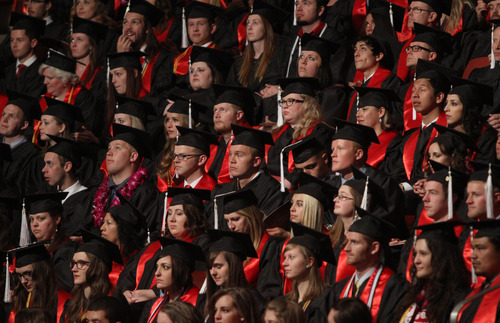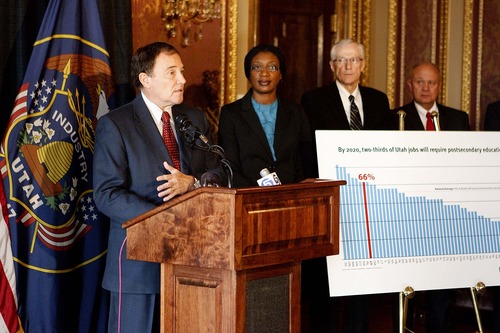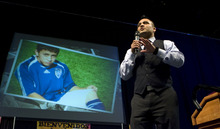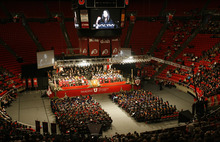This is an archived article that was published on sltrib.com in 2013, and information in the article may be outdated. It is provided only for personal research purposes and may not be reprinted.
Utah must significantly ramp up the number of people earning college degrees and certificates to meet its goal of increasing those numbers to 66 percent by the year 2020, according to a new report.
If progress continues at the current rate, the state will increase the number of degree-holders by just over 1 percent a year, the nonprofit Lumina Foundation projected.
"Clearly, Utah has a long way to go," the report found. The study indicated that minorities in Utah are falling behind their national counterparts and a relatively high number of Utahns start college but don't finish.
"Encouraging and helping these adults to complete degrees would go a long way toward helping Utah reach the ... goal," the report said.
Earlier this year, the Utah Legislature adopted Gov. Gary Herbert's goal of bringing the portion of Utahns with degrees or certificates from 43 percent now to 66 percent over the next seven years. The Lumina Foundation has a similar aim: It wants 60 percent of all Americans to have a two- or four-year degree by 2025.
The group found some things to like about Utah in its annual report: 2011 U.S. Census data show 40.3 percent of Utahns have an associate or bachelor's degree — a figure that beats the national average and ranks Utah as having the 19th-highest educational attainment in the country.
But the number of adults who have attended college without earning a degree is also high —28 percent compared to 22 percent in the rest of the country.
That group includes Meredith Greer, a 35-year-old Saratoga Springs resident who was a good student in high school. She enrolled at then-Dixie State College after graduation.
But "in the beginning, I had no direction at all," she said, and she left after about a semester. Greer returned home to Utah County and within a year married a returned missionary for The Church of Jesus Christ of Latter-day Saints. The couple had a daughter but divorced within three years.
A 23-year-old Greer found herself working an $8.39-an-hour nursing assistant job, struggling to make her mortgage payments and care for a young child.
"It's the hardest job in the world," she said. Though she started a nursing degree at then-Utah Valley State College, she went back to work to add to her family's income when she remarried.
"I've never been a stay-at-home mom, but I've also never had choices because of the choices I made," she said.
Now working for a call center in Draper, she drills the value of education into the heads of her own five children.
"I promised myself I would give my children the gift of education. I'll work full-time for all my kids," she said. "I don't want them to be stuck between a rock and a hard place, ever."
Parental involvement is also essential for Latino students, said Jose Enriquez, founder and executive director of Latinos in Action. In Utah, just less than 16 percent of Latinos have degrees, compared to more than 19 percent in the U.S. as a whole, the Lumina report found.
"Usually, the first generation comes and works so the second generation can reap the rewards," Enriquez said. But if those parents don't also take a role in their children's education, the kids might not get to college and "break the cycle of poverty," he said.
"They're working so hard to give the kids what they didn't have that the American Dream is lost," said Enriquez.
Asian-Americans in Utah, meanwhile, have an attainment level that's a bit higher than white Utahns, at 44 percent.
That rate, though, falls far below the nearly 60 percent of their peers nationwide who have degrees.
Emilio Manuel Camu, vice president of the Asian-American Student Association at the University of Utah, said schools don't support programming aimed at American students of Asian descent.
"There's more emphasis for the universities to bring in international Asian students," he said.
And the Asian-American designation can mean many things, from someone whose family has been in the country for generations to a refugee from Myanmar. Utah's population is also unique for its high number of Pacific Islanders.
"Especially within Utah, I feel like people love the festivals ... but other than that there's not really an interest in Asian-American youth," he said. They "do need programs in order to retain them."
The Legislature has set aside nearly $4 million for intervention techniques designed to keep minority students in school at each grade level, as well as $10 million for early and extended-day kindergarten, said Ally Isom, deputy chief of staff for Herbert.
The Utah Women in Education Initiative, meanwhile, recently decided to focus on it efforts on helping women finish college, she said.
The 66 by 2020 plan "is an ambitious goal," she said. "We have our work cut out for us."
Twitter: @lwhitehurst —
Educational goals
The Lumnina Foundation says 40.3 percent of Utahns have two- or four-year degrees. It wants 60 percent of Americans to hold such degrees by 2025.
Utah aims to increase the number of residents with a degree or certificate to 66 percent by the year 2020. State leaders say that including postsecondary certificates, that number now rests at about 43 percent.













